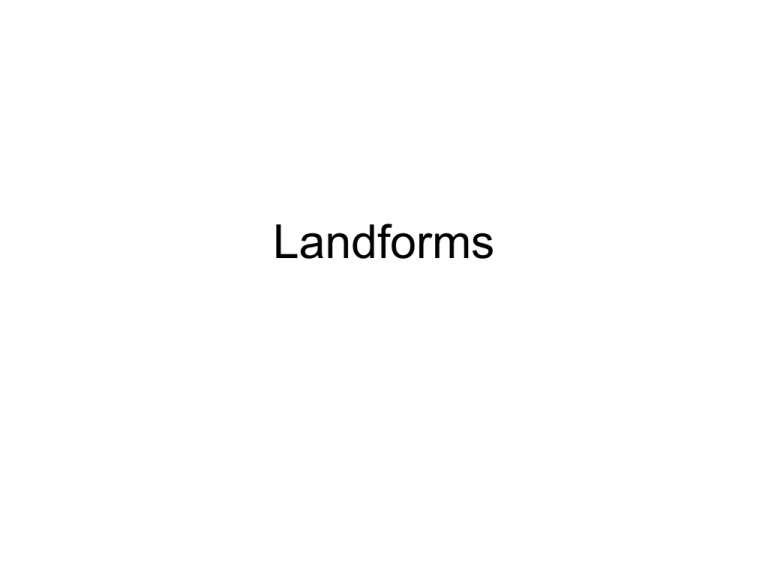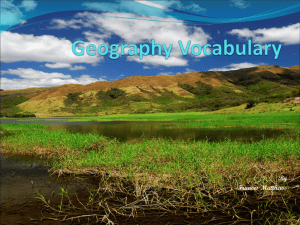Landforms and Erosion
advertisement

Landforms Coastline • White-chalk cliffs studded with beech trees form the dramatic coastline of Rugen Island, Germany. Crashing waves from the Baltic Sea sculpted the 400-foot (120meter) precipices of the island's eastern shore. Limestone Cliffs on Coastline Coastline Coastline • These unique sandbank formations in the Baltic Sea near Germany were formed about 6,000 years ago when seawaters flooded Germany, fashioning islands, sandbanks, and peninsulas from hilltops of previously dry land. Today, Germany's unique offshore landscape is part of Vorpommersche Boddenlandschaft National Park. Coastal Tunnels Coastal Tunnels, Victoria, Australia • Surf froths around the wind-and-watereroded coastal tunnels in southwestern Australia's Port Campbell National Park. Retreating tides have left jagged limestone formations around the park's coastline, giving the area its historical notoriety as a ships' graveyard. Coastal Sea Stacks Sea stacks, like this one shaped like the prow of a ship in Cape Kiwanda State Park, Oregon, are chunks of isolated rock resistant to erosion. They start as part of a headland or sea cliff connected to land. Smashing waves erode the softer rock, leaving harder rock behind in the form of sea stacks. Basalt Columns • Towering in close symmetry, these basalt columns near Fingal’s Cave form the base of the Scottish island of Staffa. The columns formed when cooling lava flows met bedrock and the region’s cold weather. The island contains three main caves. Ocean Tides • Ocean tides comb the waters of coastal Alaska into fanciful eddies and whorls. The ebb and flow of tides help sculpt an array of landforms on coasts worldwide, including spits, barrier islands, and dunes. Island • Surf hits turf on the coastline of the Chandeleur Islands. Arranged in a crescent along the southeastern coast of Louisiana, the barrier islands are Louisiana's first line of defense from storm damage. The surging waters of Hurricane Katrina submerged half of the low-lying islands. Bora Bora (Island) Blue Hole Reef Lake Granite Outcrops in a Lake • Ancient granite outcrops reflect in the still water of Sylvan Lake in South Dakota's Custer State Park as a lone fisherman awaits a nibble. Geologists calculate that the park's granite, into which the sculptures at nearby Mount Rushmore were carved, are about 1.7 billion years old, making it some of the oldest rock in North America. Mountains • The jagged peaks of Antarctica's Filchner Mountains rise in the distance as an intrepid mountaineering team makes camp on an ice field. Mountain Climbers Mountain • A delicate necklace of snow melts from the summit of Tanzania's highest peak, Mount Kilimanjaro. Global warming is changing the face of mountains worldwide, eliminating snowcapped peaks and giving birth to surging melt-fed rivers. Volcanoes • In Hawai'i Volcanoes National Park, Kilauea erupts sending lava high into the air. This molten rock comes from deep within the Earth, where residual heat from the planet's formation combines with heat from the gradual decay of radioactive elements trapped below. Caves • Lava-tube caves, like this one in California's Lava Beds National Monument, are found throughout the world. These unique underground structures form during long-lasting lava flows. As lava moves through a channel, overflows build natural levees along the sides, which can eventually connect and harden, forming a canopy. Just as a winter stream continues to flow beneath its ice cap, lava continues to move under this roof. When flow from the source stops, the remaining lava moves through to the end, leaving a hollow tube, often large enough to walk through. Caves • A spelunker in a glacier cave in Greenland gazes upon colors and shapes that look more like a swirling galaxy than a cave formation. The otherworldly contours of this ice chamber were formed by the heat of a geothermal spring Caves • Looking like the set of a science fiction movie, China's Reed Flute Cave is bathed in purple-blue light. Created by an underground river more than a half million years ago, this highly accessible karst formation is one of the region's most popular tourist attractions. But during World War II the cave served a different purpose—it doubled as an air raid shelter. Caves Desert Badlands • A storm passes over Yellow Mounds Overlook in South Dakota’s Badlands, casting light and shadow below. Although the region’s name derives from the Oglala Sioux words mako sica or "land bad," the Badlands showcase the powerful effects of wind and water and contain fossil beds dating to 35 million years ago. Desert Badlands Desert • Towers of salt and a riverbed colored by crystallized salt create an otherworldly landscape in Ethiopia’s Danakil Desert. Sitting more than 300 feet (90 meters) below sea level, with temperatures reaching 120 degrees Fahrenheit (49 degrees Celsius), local inhabitants prize the Danakil for one thing: its salt deposits. Desert Plateau Desert • Massive, disorderly rock formations jut from the orange Saharan sand of Chad's Ouri Valley. This desert valley is bordered by the Tibesti Mountains. Wind Erosion in the Desert Desert Sand Dunes Sandstone Swirls Tufa • With the snowdraped Sierra Nevada as a backdrop, unique erosion formations called sand tufa stand like giant cauliflower stalks in a dry Arizona lake bed. Before this alkaline lake went dry, tufa formed when a freshwater spring percolated from below and formed calcium carbonate deposits. When the lake's level dropped, these fragile formations surfaced, and wind went to work removing the sand beneath the deposits. Anticline (Plate Tectonics) • Raplee Ridge, part of the Monument Upwarp in southeastern Utah, is a long, narrow, folded anticline that formed about 70 million to 50 million years ago. Plate Tectonics • In the Persian Gulf, two tectonic plates collide. The Arabian plate (lower left) is running up on the Eurasian plate (upper right). The Persian Gulf (top) and the Gulf of Oman (bottom) were once the site of a rift, a place where two plates pull apart from each other, and the Indian Ocean filled in the widening gap between the two plates. However, the process then reversed, and about 20 million years ago, the gulf began to close up. The collision of the two continental plates gives Iran its mountainous terrain. Glacier • The Bernard Glacier in Alaska's Saint Elias Mountains looks like a huge alpine highway. Glaciers are slow but highly effective shapers of the land, essentially carrying away anything in their path—from soil and rocks to hills and even the sides of mountains. Valleys • Glaciers carved this steep-walled valley, now occupied by the Merced River, in California's Yosemite National Park. Waterfalls cascade down the valley's steep walls, carved away by the massive, slow-moving blocks of snow and ice. Valley Vineyard Gorge • A deep gorge drops some 650 feet (198 meters) near the abandoned city of Araden, Crete. Visitors can descend into the gorge and walk a little more than 4 miles (6.4 kilometers) to the Mediterranean Sea. In addition to magnificent scenery, the gorge provides a 2,460-foot (750meter) descent to the sea. Colorado River Canyon • The red of cactus blooms pops in a Grand Canyon valley. Cut by the Colorado River over millions of years, the Grand Canyon is considered one of the finest examples of aridland erosion in the world. The immense canyon is 277 miles (446 kilometers) long and averages 4,000 feet (1,200 meters) deep, but it is only 15 miles (24 kilometers) across at its widest. Colorado River • Water rushes around rocks as the Colorado River continues to cut its way through the Grand Canyon. It takes two days by foot or mule to get to the bottom of the Grand Canyon and back, and at least two weeks to complete the journey through the canyon by raft. In 1963 the Glen Canyon Dam was completed upstream of the Grand Canyon, radically changing the flow of the Colorado. River Delta • Standing in stark contrast to the surrounding desert, vegetation lines the fertile Nile River valley as it runs northward through Egypt. The city of Cairo is a gray smudge visible where the river widens into its fan-shaped delta. River Delta Meandering River • With Mexico on the left and the United States on the right, the Rio Grande forges a clear barrier between the two countries. On the U.S. side the river winds through the Santa Elena Canyon in Texas' Big Bend National Park. Towering 1,500-foot (460meter) cliffs of solid limestone mark the canyon. Meandering River • Porsmork Valley is part of Iceland's rich landscape and host to thousands of plant species. Glacial valleys, such as this one, have wide valley floors usually littered with loose rock and boulders left behind by the massive moving ice slabs. Meandering River • The Snake River wends through wooded flats in Grand Teton National Park, Wyoming. A wide, sagecovered plain, home to bison and moose, stretches across the valley to the base of the jagged Teton Range, which rises abruptly from the valley floor. Meandering River Waterfall • A waterfall cascades down the sheer face of the Grand Canyon in Arizona. In addition to the mighty Colorado River running through the canyon, water— a vital resource in the arid Southwest— exists in the form of springs, streams, and seeps. Slot Canyon • A slot canyon scores the Arizona desert, just one of many dotting the state's border with Utah. Slot canyons are comparatively short and unusually narrow canyons that can be several hundred feet deep. A region needs a special combination of rainfall and geographical features to make slot canyons possible. Rainwater and snowmelt cut and rubbed the red rock of this region for eons to form these slots. Slot Canyon Canyon • Carved rock stretches as far as the eye can see in Canyon de Chelly National Monument in Arizona. Canyon de Chelly is unique among U.S. national parks—it is composed entirely of Navajo Tribal Trust Land, which remains home to a Navajo community. According to Navajo beliefs, a deity named Spider Woman lived on top of Spider Rock, the sandstone monolith in the foreground of this picture. She devoured children who misbehaved, and their bleached bones turned the top of Spider Rock white. Plateau • Mount Roraima, a tepui, or sandstone mesa, rises from the clouds in southeastern Venezuela. These rare 4,000-foot (1,200-meter) plateaus have lured adventurers to Venezuela's canyonlands for decades, and are believed to have inspired Sir Arthur Conan Doyle to write his 1912 novel, The Lost World. Plateau Colorado Plateau Plateau Plains • A massive boab tree, close relative of the African and Madagascan baobabs, stands alone amid the golden grasses of a plain near the town of Wyndham in Western Australia. Much of Western Australia's 7,800 miles (12,500 kilometers) of coastline gives way to broad coastal plains, such as this one, that extend inland to the state's hot, dry central plateau, known as the outback. Serengeti Plain • Two zebras graze the grassland at dusk in Kenya's Masai Mara National Reserve. Every year, the reserve's 200,000 zebras join 1.5 million wildebeests in an epic migration, following the rain more than 300 miles (480 kilometers) from Tanzania into Kenya in the dry season, then south again to foal on the storm-soaked Serengeti Plain.







